
Parsnips look like a pale carrot and are actually a relative of the
carrot, celeriac, and parsley root. Commonly found in Europe, this root
vegetable arrived to the United States with the colonists. Popular in the 19th and
early 20th centuries for its celery flavor and nutty fragrance, this
vegetable was often used in recipes that called for caloric decadence.
|
|
Parsnips |
Serving size ½ cup,
cooked (78g)
|
Amount Per Serving |
% Daily
Value |
| Calories
60 |
|
| Calories
from Fat 0 |
|
| Total Fat 0g |
0% |
|
Cholesterol 0mg |
0% |
| Sodium
10mg |
0% |
| Total
Carbohydrate 13g |
4% |
|
Dietary Fiber 3g |
12% |
|
Sugars 4g |
|
| Protein
1g |
|
| Vitamin A |
0% |
| Vitamin C |
15% |
| Calcium |
2% |
| Iron |
2% |
* Percent Daily Values are based on a
2,000 calorie diet. |
|
| |
|
Parsnips are available year round with a peak from fall into spring. They
are often displayed with the parsley root, so be sure you know which is a
parsnip. Parsley roots are typically sold with their feathery greens whereas
parsnips are sold by the root.
Select medium sized roots with uniform creamy beige skin. Avoid limp,
pitted, or shriveled roots. Store parsnips unwashed wrapped in paper towel,
placed in plastic, and store in the vegetable crisper of the refrigerator
for about 2 weeks.
Wash, peel, and trim parsnips as you would a carrot. If steaming, then the
parsnips skins will slip off after cooking. If pureeing parsnips, then leave
skins intact.
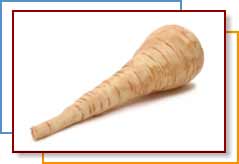
|
|
Beets |
Serving size ½ cup,
cooked (85g)
|
Amount Per Serving |
% Daily
Value |
| Calories
35 |
|
| Calories
from Fat 0 |
|
| Total Fat 0g |
0% |
|
Cholesterol 0mg |
0% |
| Sodium
65mg |
3% |
| Total
Carbohydrate 8g |
3% |
|
Dietary Fiber 2g |
8% |
|
Sugars 7g |
|
| Protein
1g |
|
| Vitamin A |
0% |
| Vitamin C |
6% |
| Calcium |
2% |
| Iron |
4% |
* Percent Daily Values are based on a
2,000 calorie diet. |
|
| |
|
Beets used to be only found in salad bars in canned form, and on
European menus, but with the culinary winds changing, this root is
now commonly seen in stateside grocery stores everywhere. This root
vegetable like its turnip cousin has two parts — the edible root and
the edible green leaves.
There are too many varieties to list here, but with more than one
type of beet to choose from, why not try one of each if you get the
chance. This versatile vegetable can be eaten raw, baked, steamed,
pickled, and served as a condiment or alongside soups and entrees.
Beets are available year-round because they thrive in more than
30 states with June through October being their peak season.
These roots come in all shapes, sizes, and colors so try a variety
to find your favorite.
Young beets, about an inch and a ½-inch diameter are fine
textured, tender, and excellent in salads. Medium and large size
beets are good for cooking; very large roots are too woody for
eating regardless of cooking method. Which ever size of beets you
choose, look for smooth, hard, uniformly round beets that are free
of cuts and bruises.
It’s best to store beets that have their tops chopped off in
individual plastic bags in the coolest part of the refrigerator.
These should last up to one week. The greens should be eaten as soon
as possible.
Wash and scrub the beets before cooking. Beets peel best after
cooking, so be sure to wear disposable gloves to minimize red stains
on hands.
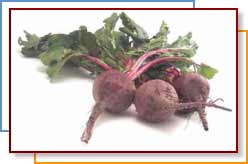
|
|
Turnips |
Serving size ½ cup,
cooked (78g)
|
Amount Per Serving |
% Daily
Value |
| Calories
15 |
|
| Calories
from Fat 0 |
|
| Total Fat 0g |
0% |
|
Cholesterol 0mg |
0% |
| Sodium
10mg |
0% |
| Total
Carbohydrate 4g |
1% |
|
Dietary Fiber 2g |
7% |
|
Sugars 2g |
|
| Protein
1g |
|
| Vitamin A |
0% |
| Vitamin C |
15% |
| Calcium |
2% |
| Iron |
0% |
* Percent Daily Values are based on a
2,000 calorie diet. |
|
| |
|
This root vegetable has been found all over Europe and Asia for
centuries. A turnip looks larger than a radish and is a well known food
source for both the root and greens. Turnips come in all shapes, sizes,
and colors.
Turnips are available year round with a peak in the fall and winter
months. Select smooth surfaced roots that are firm and heavy with some
root hairs at the bottom. In general, the smaller the turnip, the sweeter
the taste. Turnips keep well; cut the greens and bag them separately from
the root placing them in the crisper section of the refrigerator for up to
a week. Turnips can be peeled before cooking, eaten raw, or sliced, diced,
or julienned. When cooking this delicate root, cook only to the just
tender point; avoid overcooking as sweetness will diminish.
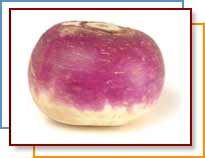
|
|
Rutabaga |
Serving size ½ cup,
cooked (85g)
|
Amount Per Serving |
% Daily
Value |
| Calories
35 |
|
| Calories
from Fat 0 |
|
| Total Fat 0g |
0% |
|
Cholesterol 0mg |
0% |
| Sodium
15mg |
1% |
| Total
Carbohydrate 7g |
2% |
|
Dietary Fiber 2g |
7% |
|
Sugars 5g |
|
| Protein
1g |
|
| Vitamin A |
0% |
| Vitamin C |
25% |
| Calcium |
4% |
| Iron |
2% |
* Percent Daily Values are based on a
2,000 calorie diet. |
|
| |
|
A cousin to the turnip, rutabagas are a cross between a cabbage and a
turnip. Virtually unknown in the United States until the 19th century, this
root gets its name from the Swedish word ‘rotabagge’ meaning round root.
People have avoided this root because it is a cruciferous vegetable that
becomes more flavored and odorous when cooked.
Rutabagas are available year round with a peak in the fall and winter.
These roots range from tan to violet in color and are much larger than
turnips; choose smooth, heavy, and firm roots. Smaller rutabagas, 4" in diameter, tend to have sweeter flavor. This root stores for
about 2 weeks in the refrigerator or at room temperature for a week.
Rutabagas are usually covered in wax, so it’s best to quarter the root,
then peel the skin before cooking.
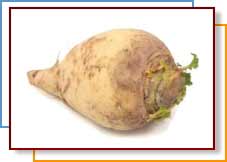
|
|
Celery Root |
Serving size ½
cup, cooked (78g)
|
Amount Per Serving |
% Daily
Value |
| Calories
20 |
|
| Calories
from Fat 0 |
|
| Total Fat 0g |
0% |
|
Cholesterol 0mg |
0% |
| Sodium
45mg |
2% |
| Total
Carbohydrate 5g |
2% |
|
Dietary Fiber 1g |
4% |
|
Sugars 0g |
|
| Protein
1g |
|
| Vitamin A |
0% |
| Vitamin C |
4% |
| Calcium |
2% |
| Iron |
2% |
* Percent Daily Values are based on a
2,000 calorie diet. |
|
| |
|
Part of the celery family, the celery root or celeriac, is routinely
used in French cooking and is seen throughout Europe. It is solely grown
for its root use and appeared in the United States beginning in the 19th century.
This root is bypassed by many because of it unusual appearance of crevices
and rootlets. When cooked well, this root evokes celery and parsley
flavors.
Celery roots are available year-round with a peak during November
through April. Select roots that are the least knobby or ones that have
the smoothest skin (for easier peeling). Medium roots tend to be smoother
and harder and these roots can be sold with or with out the celery tops.
If you do buy the roots with the tops, trim the stalks and save them for
soups and stews. The roots should be wrapped in plastic, stored in the
refrigerator, and used within a week. Celery roots must be scrubbed,
trimmed at the top and bottom, quartered, and then peeled before eating.
Be sure to discard any spongy parts. Avoid overcooking celery root as it
will go quickly from firm to mushy.
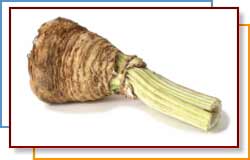
|
|
Horseradish |
Serving size
1 tablespoon, raw
|
Amount Per Serving |
% Daily
Value |
| Calories
10 |
|
| Calories
from Fat 0 |
|
| Total Fat 0g |
0% |
|
Cholesterol 0mg |
0% |
| Sodium
0mg |
0% |
| Total
Carbohydrate 2g |
1% |
|
Dietary Fiber 0g |
0% |
|
Sugars 0g |
|
| Protein
0g |
|
| Vitamin A |
0% |
| Vitamin C |
30% |
| Calcium |
2% |
| Iron |
2% |
* Percent Daily Values are based on a
2,000 calorie diet. |
|
| |
|
Horseradish is a member of the mustard family and is native to Eastern
Europe, although it may have originated in Asia, Germany, or the
Mediterranean area. The ancient Greeks used it, so did the Hebrews — it is
one of the 5 bitter herbs of the Jewish Passover. The strong flavor of
this root has an underlying sweetness and seems more like garlic than a
spice.
Horseradish roots are available year round but are plentiful during the
fall and early spring. Buy roots that are hard avoiding sprouting,
greenish tinges, blemishes, and shriveling.
Store these roots in plastic bags and refrigerate up to a week or freeze
grated root in an airtight container for several months. Scrub the root
and peel the brown skin. Finely grate or food process the root.
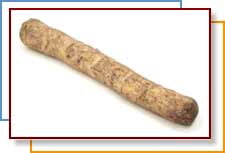
|
|
Salsify |
Serving size ½
cup (67g)
|
Amount Per Serving |
% Daily
Value |
| Calories 50 |
|
| Calories
from Fat 0 |
|
| Total Fat 0g |
0% |
|
Cholesterol 0mg |
0% |
| Sodium
15mg |
1% |
| Total
Carbohydrate 12g |
4% |
|
Dietary Fiber 2g |
7% |
|
Sugars 2g |
|
| Protein
2g |
|
| Vitamin A |
0% |
| Vitamin C |
8% |
| Calcium |
4% |
| Iron |
2% |
* Percent Daily Values are based on a
2,000 calorie diet. |
|
| |
|
Salsify is called vegetable oyster because of its faint oyster-like
flavor. This name is used interchangeably to describe two roots. White
salsify is pale, thin, forked, has rootlets at the bottom, while black
salsify (scorzonera) looks like a brown carrot and is much smoother and
longer looking. Popular in Europe since the 16th century, this root has
just begun to make its appearance in markets.
This root is available from fall to early spring. Select medium size
roots that are smooth and firm. Larger roots are more fibrous and smaller
roots have less meat. White salsify is sold in bunches with leaves still
attached. Black salsify is usually sold without leaves and in plastic
bags. Salsify will last 2 weeks wrapped in plastic and stored in the
refrigerator. Prepare salsify by scrubbing with a brush, removing the
skin, rootlets, and all dark spots. Trim the tops and bottoms and slice as
you would a carrot or leave whole. Avoid overcooking this root as it will
quickly turn into mush.
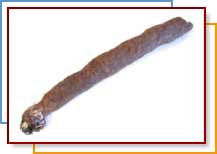
Recipes
Roots ― Quick & Simple
Makes 4 servings (½ cup servings each)
Each serving equals 1/2 cup of fruit or vegetables
Ingredients
2 medium parsnips or rutabagas, peeled and cut in ¾" x ¼" strips
2 medium carrots, peeled and cut in ¾’ x ¼" strips
1 tsp olive oil
1/8 tsp salt
1/8 tsp black pepper
Place in steamer basket over boiling water and steam for 15 minutes,
lifting cover periodically during steaming to release steam and acids that
can contribute to bitterness. Check for desired tenderness at 15 minutes;
cook longer if softer texture is desired.
Remove from steamer basket, empty water from pan, return parsnips and
carrots to pan and season lightly with olive oil, salt and fresh ground
pepper. Shake or stir gently to coat with seasonings.
Serve immediately or leave partially covered to conserve heat until ready
to serve.
Nutritional analysis per serving: Calories 89, Protein 1g, Fat 1g, Percent
Calories From Fat 14%, Cholesterol 0mg, Carbohydrates 19g, Fiber 4g,
Sodium 77mg.
Find more in our
recipe database!
|



